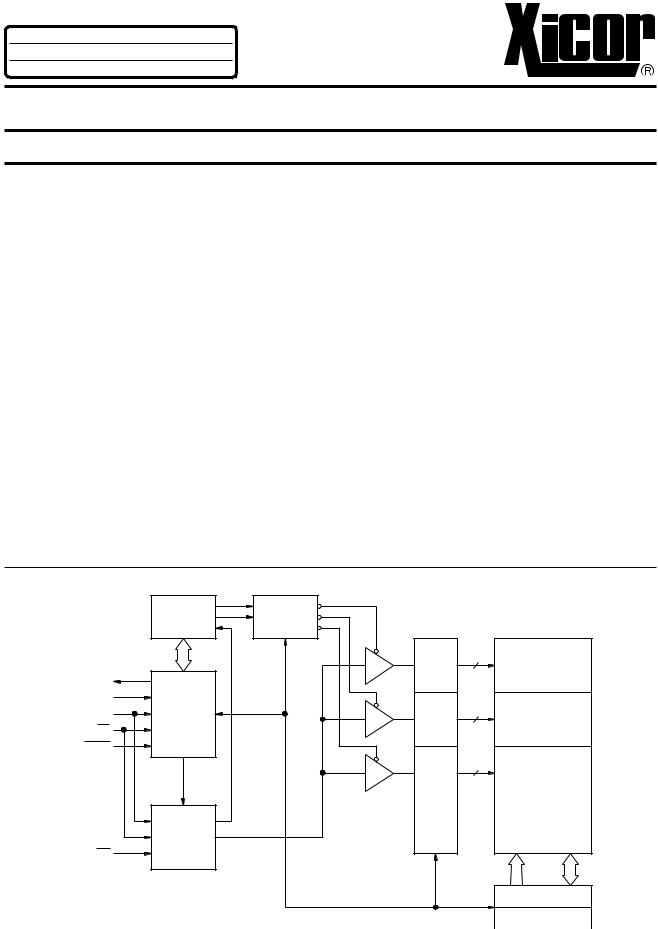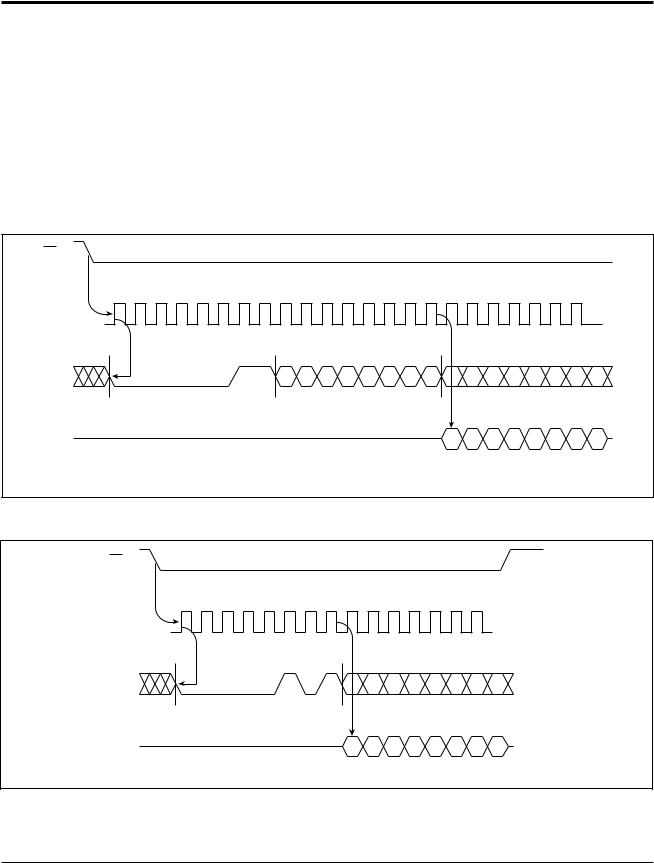XICOR X25020SI-3, X25020SI, X25020SI-2,7, X25020S-3, X25020S-2,7 Datasheet
...
APPLICATION NOTES
A V A I L A B L E
X25020AN9 • AN18 • AN31 • AN37 • AN40
2K |
X25020 |
256 x 8 Bit |
SPI Serial E2PROM with Block LockTM Protection
FEATURES
•1MHz Clock Rate
•SPI Modes (0,0 & 1,1)
•256 X 8 Bits
—4 Byte Page Mode
•Low Power CMOS
—10 μA Standby Current
—3mA Active Write Current
•2.7V To 5.5V Power Supply
•Block Lock Protection
—Protect 1/4, 1/2 or all of E 2PROM Array
•Built-in Inadvertent Write Protection —Power-Up/Power-Down protection circuitry —Write Latch
—Write Protect Pin
•Self-Timed Write Cycle
—5ms Write Cycle Time (Typical)
•High Reliability
—Endurance: 100,000 cycles per byte —Data Retention: 100 Years
—ESD protection: 2000V on all pins
•8-Lead PDlP Package
•8-Lead SOIC Package
DESCRIPTION
The X25020 is a CMOS 2048-bit serial E2PROM, internally organized as 256 x 8. The X25020 features a serial interface and software protocol allowing operation on a simple three-wire bus. The bus signals are a clock input (SCK) plus separate data in (SI) and data out (SO) lines. Access to the device is controlled through a chip select (CS) input, allowing any number of devices to share the same bus.
The X25020 also features two additional inputs that provide the end user with added flexibility. By asserting the HOLD input, the X25020 will ignore transitions on its inputs, thus allowing the host to service higher priority interrupts. The WP input can be used as a hardwire input to the X25020 disabling all write attempts, thus providing a mechanism for limiting end user capability of altering the memory.
The X25020 utilizes Xicor’s proprietary Direct Write™ cell, providing a minimum endurance of 100,000 cycles per byte and a minimum data retention of 100 years.
FUNCTIONAL DIAGRAM
|
STATUS |
WRITE |
|
|
|
PROTECT |
X DECODE |
256 BYTE |
|
|
REGISTER |
|||
|
LOGIC |
LOGIC |
ARRAY |
|
|
|
|||
|
|
|
16 |
16 X 32 |
|
|
|
|
|
SO |
|
|
|
|
SI |
COMMAND |
|
|
|
DECODE |
|
|
|
|
SCK |
|
16 |
|
|
AND |
|
16 X 32 |
||
|
|
|||
CS |
CONTROL |
|
|
|
HOLD |
LOGIC |
|
|
|
|
|
|
|
|
|
|
|
32 |
32 X 32 |
|
|
|
|
|
|
WRITE |
|
|
|
|
CONTROL |
|
|
|
|
AND |
|
|
|
WP |
TIMING |
|
|
|
LOGIC |
|
|
|
|
|
|
4 |
8 |
|
|
|
|
||
|
|
|
|
Y DECODE |
|
|
|
|
DATA REGISTER |
Direct Write™ and Block Lock™ Protection is a trademark of Xicor, Inc. |
|
|
3834 FHD F01 |
|
|
|
|
|
|
©Xicor, Inc. 1994, 1995, 1996 Patents Pending |
Characteristics subject to change without notice |
|||
3834-1.8 6/10/96 T3/C1/D0 NS |
1 |
|
|
|

X25020
PIN DESCRIPTIONS
Serial Output (SO)
SO is a push/pull serial data output pin. During a read cycle, data is shifted out on this pin. Data is clocked out by the falling edge of the serial clock.
Serial Input (SI)
SI is the serial data input pin. All opcodes, byte addresses, and data to be written to the memory are input on this pin. Data is latched by the rising edge of the serial clock.
Serial Clock (SCK)
The Serial Clock controls the serial bus timing for data input and output. Opcodes, addresses, or data present on the SI pin are latched on the rising edge of the clock input, while data on the SO pin change after the falling edge of the clock input.
Chip Select (CS)
When CS is HIGH, the X25020 is deselected and the SO output pin is at high impedance and unless an internal write operation is underway, the X25020 will be in the standby power mode. CS LOW enables the X25020, placing it in the active power mode. It should be noted that after power-up, a HIGH to LOW transition on CS is required prior to the start of any operation.
Write Protect (WP)
When WP is LOW, nonvolatile writes to the X25020 are disabled, but the part otherwise functions normally. When WP is held HIGH, all functions, including nonvolatile writes operate normally. WP going LOW while CS is still LOW will interrupt a write to the X25020. If the internal write cycle has already been initiated, WP going LOW will have no affect on a write.
Hold (HOLD)
HOLD is used in conjunction with the CS pin to select the device. Once the part is selected and a serial sequence is underway, HOLD may be used to pause the serial communication with the controller without resetting the serial sequence. To pause, HOLD must be brought LOW while SCK is LOW. To resume communication, HOLD is brought HIGH, again while SCK is LOW. If the pause feature is not used, HOLD should be held HIGH at all times.
PIN CONFIGURATION
|
|
|
|
|
|
|
DIP/SOIC |
|
|
|
|
|
|
|
|
|
|
|
|
|
|
|
|
|
|
|
|
|
|
1 |
|
8 |
|
|
|
|
||
|
|
CS |
|
|
|
|
|
VCC |
||||
|
|
|
||||||||||
|
|
|
||||||||||
|
SO |
|
2 |
|
7 |
|
|
|
|
|||
|
|
X25020 |
|
HOLD |
||||||||
|
|
|||||||||||
|
|
|
|
|
|
3 |
6 |
|
|
|
|
|
|
WP |
|
|
|
|
SCK |
||||||
|
|
|
||||||||||
VSS |
|
4 |
|
5 |
|
SI |
||||||
|
|
|
||||||||||
|
|
|
||||||||||
|
|
|
|
|
|
|
|
|
|
|
|
3834 FHD F02.1 |
|
|
|
|
|
|
|
|
|
|
|
|
|
PIN NAMES
Symbol |
Description |
|
|
CS |
Chip Select Input |
|
|
SO |
Serial Output |
|
|
SI |
Serial Input |
SCK |
Serial Clock Input |
WP |
Write Protect Input |
|
|
VSS |
Ground |
VCC |
Supply Voltage |
HOLD |
Hold Input |
|
|
3834 PGM T01.1
2

X25020
PRINCIPLES OF OPERATION
The X25020 is a 256 x 8 E2PROM designed to interface directly with the synchronous serial peripheral interface (SPI) of many popular microcontroller families.
The X25020 contains an 8-bit instruction register. It is
accessed via the SI input, with data being clocked in on the rising SCK. CS must be LOW and the HOLD and WP
inputs must be HIGH during the entire operation.
Table 1 contains a list of the instructions and their opcodes. All instructions, addresses and data are transferred MSB first.
Data input is sampled on the first rising edge of SCK after CS goes LOW. SCK is static, allowing the user to stop the clock and then resume operations. If the clock line is shared with other peripheral devices on the SPI bus, the user can assert the HOLD input to place the X25020 into a “PAUSE” condition. After releasing HOLD, the X25020 will resume operation from the point when HOLD was first asserted.
Write Enable Latch
The X25020 contains a “write enable” latch. This latch must be SET before a write operation will be completed internally. The WREN instruction will set the latch and the WRDI instruction will reset the latch. This latch is automatically reset upon a power-up condition and after the completion of a byte, page, or status register write cycle.
Table 1. Instruction Set
Status Register
The RDSR instruction provides access to the status register. The status register may be read at any time, even during a write cycle. The status register is formatted as follows:
7 |
6 |
5 |
4 |
3 |
2 |
1 |
0 |
|
|
|
|
|
|
|
|
X |
X |
X |
X |
BP1 |
BP0 |
WEL |
WIP |
3834 PGM T02
BP0 and BP1 are set by the WRSR instruction. WEL and WIP are read-only and automatically set by other operations.
The Write-In-Process (WIP) bit indicates whether the X25020 is busy with a write operation. When set to a “1”, a write is in progress, when set to a “0”, no write is in progress. During a write, all other bits are set to “1”.
The Write Enable Latch (WEL) bit indicates the status of the “write enable” latch. When set to a “1”, the latch is set, when set to a “0”, the latch is reset.
The Block Protect (BP0 and BP1) bits are nonvolatile and allow the user to select one of four levels of protection. The X25020 is divided into four 512-bit segments. One, two, or all four of the segments may be protected. That is, the user may read the segments but will be unable to alter (write) data within the selected segments. The partitioning is controlled as illustrated below.
Status Register Bits |
Array Addresses |
|
BP1 |
BP0 |
Protected |
|
|
|
0 |
0 |
None |
|
|
|
0 |
1 |
$C0–$FF |
|
|
|
1 |
0 |
$80–$FF |
|
|
|
1 |
1 |
$00–$FF |
3834 PGM T03
Instruction Name |
Instruction Format* |
Operation |
||
|
|
|
|
|
WREN |
0000 |
0110 |
Set the Write Enable Latch (Enable Write Operations) |
|
|
|
|
|
|
WRDI |
0000 |
0100 |
Reset the Write Enable Latch (Disable Write Operations) |
|
|
|
|
||
RDSR |
0000 0101 |
Read Status Register |
||
|
|
|
||
WRSR |
0000 0001 |
Write Status Register |
||
|
|
|
|
|
READ |
0000 |
0011 |
Read Data from Memory Array beginning at selected address |
|
WRITE |
0000 |
0010 |
Write Data to Memory Array beginning at Selected Address |
|
(1 to 32 Bytes) |
||||
|
|
|
||
|
|
|
|
|
|
|
|
3834 PGM T04 |
|
*Instructions are shown MSB in leftmost position. Instructions are transferred MSB first.
3

X25020
Clock and Data Timing
Data input on the SI line is latched on the rising edge of SCK. Data is output on the SO line by the falling edge of SCK.
Read Sequence
When reading from the E2PROM memory array, CS is first pulled LOW to select the device. The 8-bit READ instruction is transmitted to the X25020, followed by the 8-bit address. After the READ opcode and address are sent, the data stored in the memory at the selected address is shifted out on the SO line. The data stored in memory at the next address can be read sequentially by continuing to provide clock pulses. The address is automatically incremented to the next higher address after each byte of data is shifted out. When the highest address is reached ($FF) the address counter rolls over to address $00 allowing the read cycle to be continued indefinitely. The read operation is terminated by taking CS HIGH. Refer to the read E2PROM array operation sequence illustrated in Figure 1.
To read the status register CS line is first pulled LOW to select the device followed by the 8-bit RDSR instruction. After the read status register opcode is sent, the contents of the status register are shifted out on the SO line. Figure 2 illustrates the read status register sequence.
Write Sequence
Prior to any attempt to write data into the X25020 the “write enable” latch must first be set by issuing the WREN instruction (See Figure 3). CS is first taken LOW, then the WREN instruction is clocked into the X25020. After all eight bits of the instruction are transmitted, CS must then be taken HIGH. If the user continues the write operation without taking CS HIGH after issuing the WREN instruction, the write operation will be ignored.
To write data to the E2PROM memory array, the user issues the WRITE instruction, followed by the address and then the data to be written. This is minimally a thirtytwo clock operation. CS must go LOW and remain LOW for the duration of the operation. The host may continue to write up to 4 bytes of data to the X25020. The only restriction is that the 4 bytes must reside on the same page. If the address counter reaches the end of the page and the clock continues, the counter will “roll over” to the first address of the page and overwrite any data that may have been written.
For the write operation (byte or page write) to be completed, CS can only be brought HIGH after bit 0 of data byte N is clocked in. If it is brought HIGH at any other time the write operation will not be completed. Refer to Figures 4 and 5 below for a detailed illustration of the write sequences and time frames in which CS going HIGH are valid.
To write to the status register, the WRSR instruction is followed by the data to be written. Data bits 0, 1, 4, 5, 6 and 7 must be “0”. Figure 6 illustrates this sequence.
While the write is in progress following a status register or E2PROM write sequence, the status register may be read to check the WIP bit. During this time the WIP bit will be HIGH.
Hold Operation
The HOLD input should be HIGH (at VIH) under normal operation. If a data transfer is to be interrupted HOLD can be pulled LOW to suspend the transfer until it can be
resumed. The only restriction is the SCK input must be LOW when HOLD is first pulled LOW and SCK must also
be LOW when HOLD is released.
The HOLD input may be tied HIGH either directly to VCC or tied to VCC through a resistor.
4

X25020
Operational Notes
The X25020 powers-up in the following state:
•The device is in the low power standby state.
•A HIGH to LOW transition on CS is required to enter an active state and receive an instruction.
•SO pin is high impedance.
•The “write enable” latch is reset.
Figure 1. Read E2PROM Array Operation Sequence
Data Protection
The following circuitry has been included to prevent inadvertent writes:
•The “write enable” latch is reset upon power-up.
•A WREN instruction must be issued to set the “write enable” latch.
•CS must come HIGH at the proper clock count in order to start a write cycle.
CS |
|
|
|
|
|
|
|
|
|
|
|
|
|
|
|
|
|
|
|
|
|
|
|
0 |
1 |
2 |
3 |
4 |
5 |
6 |
7 |
8 |
9 |
10 |
11 |
12 |
13 |
14 |
15 |
16 |
17 |
18 |
19 |
20 |
21 |
22 |
|
SCK |
|
|
|
|
|
|
|
|
|
|
|
|
|
|
|
|
|
|
|
|
|
|
|
|
INSTRUCTION |
|
|
|
|
|
BYTE ADDRESS |
|
|
|
|
|
|
|
|
|
|
||||||
SI |
|
|
|
|
|
|
|
7 |
6 |
5 |
4 |
3 |
2 |
1 |
0 |
|
|
|
|
|
|
|
|
HIGH IMPEDANCE |
|
|
|
|
|
|
|
|
|
|
|
|
|
|
|
DATA OUT |
|
|
|
||||
|
|
|
|
|
|
|
|
|
|
|
|
|
7 |
6 |
5 |
4 |
3 |
2 |
1 |
0 |
|||
SO |
|
|
|
|
|
|
|
|
|
|
|
|
|
|
|
||||||||
|
|
|
|
|
|
|
|
|
|
|
|
|
|
|
|
MSB |
|
|
|
|
|
|
|
|
|
|
|
|
|
|
|
|
|
|
|
|
|
|
|
|
|
|
|
|
3834 FHD F04.1 |
||
Figure 2. Read Status Register Operation Sequence
CS
0 |
1 |
2 |
3 |
4 |
5 |
6 |
7 |
8 |
9 |
10 |
11 |
12 |
13 |
14 |
SCK
INSTRUCTION
SI
DATA OUT
HIGH IMPEDANCE
SO 7 6 5 4 3 2 1 0
MSB
3834 ILL F13
5
